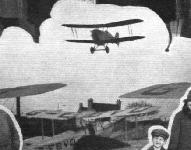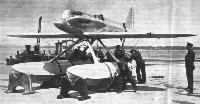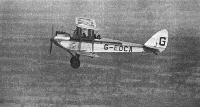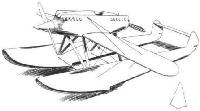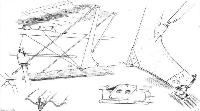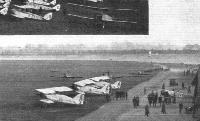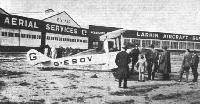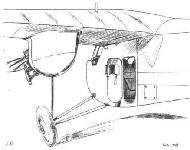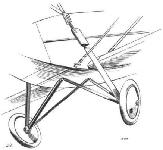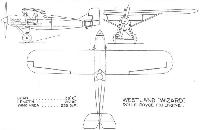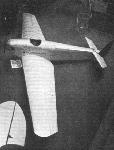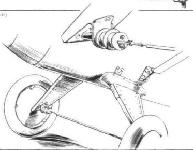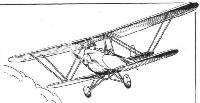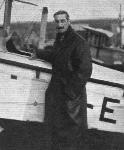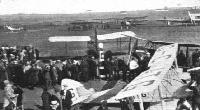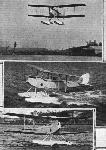Фотографии
-
HOUSEHOLD BRIGADE FLYING CLUB "AT HOME": Mr. D. A. N. Watt on his D.W.1.
Самолёты на фотографии: RAF S.E.5 - Великобритания - 1916
-
Санитарный К-4 с мотором М-6 на Берлинской авиавыставке в 1928г.
The Russian ambulance machine, type K.4, is mainly of metal construction. The two side radiators are retractable.Самолёты на фотографии: Калинин К-4 - Россия - 1928
-
AVRO "GOSPORTS" FOR ESTHONIA: A. V. Roe & Co., Ltd., of Manchester, have received an order from the Esthonian Government for a number of "Gosport" training machines, fitted with Armstrong-Siddeley "Mongoose" engines. Three of these machines are shown herewith.
Самолёты на фотографии: Avro Avro 504 - Великобритания - 1913
-
THE SPEED RECORD ATTEMPT: Testing the Napier engine of the Supermarine S.5 at Calshot.
Самолёты на фотографии: Supermarine S.5 / S.6 - Великобритания - 1927
-
FLYING IN CENTRAL AUSTRALIA: The D.H.50 (right) and ANEC III passenger machines at Hermannsburg, Central Australia, after flying 1,300 miles from Melbourne. The pilots were Capt. H. J. Larkin and Capt. F. Neale.
Самолёты на фотографии: ANEC III - Великобритания - 1926De Havilland D.H.50 - Великобритания - 1923
-
Montreal Air Meeting: General views at Montreal aerodrome on October 1, when 43 machines, including many D.H. "Moths," took part. The machines in formation are Armstrong-Whitworth "Siskins" which gave an excellent demonstration.
Самолёты на фотографии: Armstrong Whitworth Siskin - Великобритания - 1921
-
Регистрационный номер: G-EDCA "EXAMPLE BETTER THAN PRECEPT": This photograph, taken from another aeroplane, shows the Director of Civil Aviation, Sir Sefton Brancker, piloting his de Havilland "Cirrus-Moth" "D.C.A."
Самолёты на фотографии: De Havilland Moth / D.H.60 - Великобритания - 1925
-
A German Schneider Trophy Challenger? This sketch shows a model exhibited by Dornier, and representing a design for a racing seaplane. The two engines are intended to be of 1,000 h.p. each, and the long floats, of unusual cross-section, extend aft to carry the tail. The inset shows the section of the floats in the neighbourhood of the single step.
Самолёты на фотографии: Dornier Schneider Trophy 1929 - Германия - 1929
-
A Russian Mail 'Plane: The A.N.T.3 sesquiplane is of all-metal construction, and bears strong evidence of German (Junkers) influence with its corrugated Duralumin covering. The fuselage is of approximately triangular cross-section.
Самолёты на фотографии: Туполев Р-3 / АНТ-3 - Россия - 1925
-
RUSSIAN METAL CONSTRUCTION AT THE BERLIN SHOW: The mail 'plane A.N.T.3 was built entirely of Duralumin. The larger sketch shows the wing bracing, while insets illustrate details of the wing strut attachment with incidence adjustment, the step on the side of the fuselage, and the method of finishing off the trailing edge of the metal wing covering.
Самолёты на фотографии: Туполев Р-3 / АНТ-3 - Россия - 1925
-
HOUSEHOLD BRIGADE FLYING CLUB "AT HOME": Some of the thirty-odd machines gathered at Brooklands last Friday. Three Service "Atlas" Co-Ops. from No. 13 Squadron, R.A.F.
Самолёты на фотографии: Armstrong Whitworth Atlas / Ajax - Великобритания - 1925
-
Регистрационный номер: G-EBOV Mr. "Bert" Hinkler, who has now returned to England, is here seen with his Avro "Avian" (Cirrus) at the Larkin Aircraft Company's works at Melbourne during his aerial tour round Australia this year following his record flight from England.
Самолёты на фотографии: Avro Avian / Type 594/616 - Великобритания - 1926
-
ITALIAN "TROUSER FASHIONS": On the Breda monoplane the undercarriage was liberally streamlined, the fairings enclosing bent axles, radius rods and telescopic members. It seems likely that the interference drag between such large surfaces meeting at small angles is much greater than would be the case if normal thin streamline struts had been used.
Самолёты на фотографии: Breda A.7 - Италия - 1926
-
On the twin-engined Focke-Wulf machine the telescopic struts of the undercarriage are taken to the engine mountings on the wing.
Самолёты на фотографии: Focke-Wulf GL.18 / GL.22 - Германия - 1926
-
THE HEINKEL BIPLANE (H.D.22): On the left a general view of undercarriage, wing bracing, etc. The details on the right show attachment of inter-plane strut and anti-lift wires to lower wing spar.
Самолёты на фотографии: Heinkel HD.21/22/24/32/35/36 - Германия - 1924
-
The Larkin expedition's ANEC III landing near McDonnell Ranges at Alice Springs, Central Australia. The pilot was Capt. F. Neale.
Самолёты на фотографии: ANEC III - Великобритания - 1926
-
A "Worm's Eye View" of the undercarriage of the Avia light biplane.
Самолёты на фотографии: Avia BH-29 - Чехословакия - 1927
-
Регистрационный номер: J9252 THE WESTLAND "WIZARD" SINGLE SEATER FIGHTER: Three-quarter rear view.
Самолёты на фотографии: Westland Wizard - Великобритания - 1926
-
"Westland" Wizard Rolls-Royce F.XI Engine
Самолёты на фотографии: Westland Wizard - Великобритания - 1926
-
Регистрационный номер: O-BRSV The Stampe and Vertongen light monoplane, with Renard engine, was exhibited at Berlin with a "jury" undercarriage, its own having been damaged in a night landing.
Самолёты на фотографии: Stampe et Vertongen RSV.18 - Бельгия - 1929
-
A 20 H.P. RUSSIAN LIGHT MONOPLANE: The "Burewestnik" (Stormy Petrel) is a low-wing monoplane single-seater with flat twin air-cooled engine.
Самолёты на фотографии: Невдачин В.П. Буревестник С-4 - Россия - 1927
-
BOLSHEVIK UNORTHODOXY: One of two unusual undercarriages on Russian light 'planes. The wood spring axle and ply-wood covered leather-tyred wheels of the low-wing monoplane "Burewestnik." Inset, details of the attachment of axle to fuselage.
Самолёты на фотографии: Невдачин В.П. Буревестник С-4 - Россия - 1927
-
A Russian low-power two-seater: The "Tri Druga" (three friends) is a high-wing monoplane, strut braced, and mainly of wood construction.
Самолёты на фотографии: Семенов А.А., Сутугин Л.И., Горелов С.Н. Три Друга - Россия - 1928
-
BOLSHEVIK UNORTHODOXY: One of two unusual undercarriages on Russian light 'planes. The unusual springing on the strut-braced parasol monoplane "Tri Druga." The undercarriage struts are free to rock slightly from side to side, and the "axle" takes the form of a streamline wire stretched between wheel centres. Under load the wheels move outwards, stretch the wire and thus compress the rubber block shock absorbers.
Самолёты на фотографии: Семенов А.А., Сутугин Л.И., Горелов С.Н. Три Друга - Россия - 1928
-
Two views of the all-metal Reid "Rambler" light aeroplane fitted with an A.D.C. "Cirrus" Mk. II engine. It is a new Canadian production and will soon be produced, according to present plans, at the rate of seven per week.
Самолёты на фотографии: Reid Rambler - Канада - 1928
-
Sketch of the Reid "Rambler" light aeroplane, a new Canadian production, though designed by an Englishman, Mr. Reid. It has a top speed of 102 m.p.h., is of all metal construction and is fitted with hydraulic brakes. The engine is an A.D.C. "Cirrus"
Самолёты на фотографии: Reid Rambler - Канада - 1928
-
Регистрационный номер: G-AAAA A "MOTH" COUPE: The De Havilland Aircraft Co. has recently produced a variant of the standard "Gipsy Moth" by adding a small "roof" over the cockpits. The machine is not intended as a separate model, but for use in cold climates where some protection of the occupants is desirable. In the flying view the pilot may be recognised as Captain de Havilland himself, and the machine, G-AAAA, is his personal "bus."
Самолёты на фотографии: De Havilland Moth Coupe - Великобритания - 1928
-
A PRIVATE OWNER: Capt. Stewart Burt, with his D.H. "Moth X"
Самолёты на фотографии: De Havilland Gipsy Moth / Moth X - Великобритания - 1928
-
Регистрационный номер: G-CATG Montreal Air Meeting: General views at Montreal aerodrome on October 1, when 43 machines, including many D.H. "Moths," took part. The machine in foreground is the D.H. "Moth" in which Capt. F. G. M. Sparks won the important 30-mile race.
Самолёты на фотографии: De Havilland Gipsy Moth / Moth X - Великобритания - 1928
-
A "MOTH" SEAPLANE FOR SARAWAK: These three views show the first de Havilland "Gipsy Moth" to be fitted with floats. The machine has been ordered by the Sarawak (Borneo) Government. The Duralumin floats were built by Short Brothers, off whose works the machine is seen flying. The pilot was Capt. Hubert Broad.
Самолёты на фотографии: De Havilland Moth Seaplane - Великобритания - 1926
Статьи
- Flight
